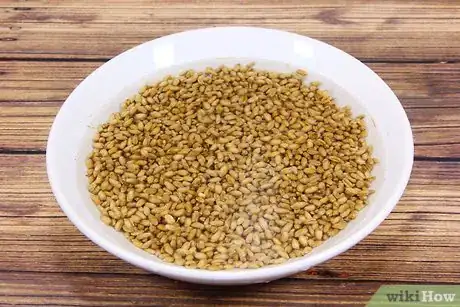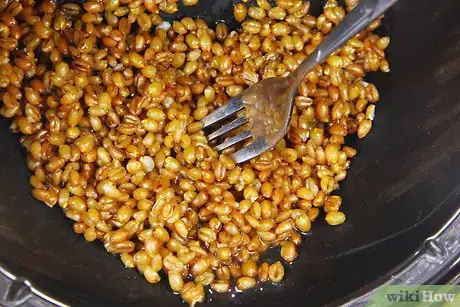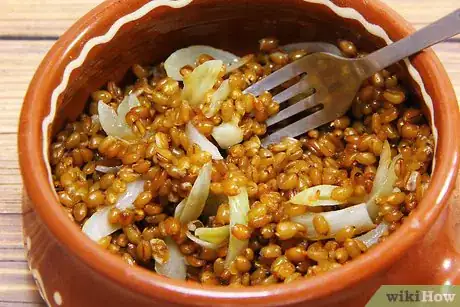This article was co-authored by wikiHow Staff. Our trained team of editors and researchers validate articles for accuracy and comprehensiveness. wikiHow's Content Management Team carefully monitors the work from our editorial staff to ensure that each article is backed by trusted research and meets our high quality standards.
There are 9 references cited in this article, which can be found at the bottom of the page.
This article has been viewed 34,370 times.
Learn more...
Pot barley is a versatile grain that is often eaten as a side dish or incorporated into soups. It is less chewy than hulled barley but less processed than pearled barley, making it a tasty but nutritious option no matter how you choose to use it. Fortunately, cooking it is also a simple process. Boil it on the stove, in your oven, or in a pressure cooker until it turns soft and fluffy.
Ingredients
- 1 cup (225 g) barley
- 3 cups (710 mL) water
- 1 cup (225 g) barley
- 3 cups (710 mL) water
- 1 tbsp (225 g) butter
- 1 tsp (5.69 g) salt
- 1 cup (225 g) barley
- 3 cups (710 mL) water
Steps
Boiling Barley on the Stove
-
1Rinse the barley off under lukewarm water. Pour all of the barley into a strainer, then set the strainer in your sink. Use the water to wash off dust and other debris. If you notice any shells or other fragments among the barley, pick them out and throw them away.[1]
-
2Combine 1 cup (225 g) of barley with 3 cups (710 mL) of water. Pour everything into a pot on your stove, stirring the grain until it is all submerged. You can cook more barley if you need to, but adjust the amount of water you use to compensate. Try to keep the ratio at 1 part barley to 3 parts water to ensure the barley has plenty of water to cook in.[2]
- For example, to make ½ cup (112.5 g) of barley, use only 1 1⁄2 cups (350 mL) of water.
- For additional flavoring, cook the barley in stock or broth instead of water.
Advertisement -
3Simmer the barley over medium-low heat for an hour. Bring the water to a boil before reducing the heat. Then, cover the pot to reduce the amount of time needed for the barley to boil. Set your timer, checking the pot on occasion to make sure the water continues to gently bubble.
- The required cooking time may vary depending on your stove’s settings.
- You can cook the barley without a lid. You may need to boil the barley for a little longer, but it will eventually cook through.
-
4Check for doneness or taste the barley for a soft, chewy texture. Barley expands as it cooks, so the finished product will look about 3 times bigger than what you put in the pot. If you’re still unsure that it is done, try the barley – if it's a soft and chewy, it's done!
- If you are familiar with other types of barley, pot barley is a little chewier than pearl barley but not as much as hulled barley.[3]
-
5Add more water if the barley isn’t done cooking and the pot is dry. Your barley may have absorbed all of the water in the pot, even if it isn't finished yet. Try adding about 1⁄4 to 1⁄2 cup (59 to 118 mL) of water and cooking until the barley reaches the consistency you desire.[4]
- If you still see water, you don’t need to add any more.
- Check the barley every 5 minutes or so to prevent it from overcooking and add more water as needed. Take it out of the pot when it reaches the consistency you desire.
-
6Drain any remaining water from the pot. Put on a pot-holder or use an oven mitt to avoid scorching your hands, then take the pot to the sink. The easiest way to drain excess water is by pouring the pot's contents into a strainer. You can also try tipping the pot to let out the excess water or moving the barley out of the pot with a slotted spoon.[5]
- If you don’t see a lot of water in the pot, you may be better off letting the barley absorb it. Cover the pot and let the barley rest for about 10 minutes.[6]
-
7Fluff the barley with a fork before serving it. While the barley is still in the pot, stir it with a form to prevent the grain from turning sticky due to released starch.[7]
-
8Store leftover barley in a sealed container in the fridge for up to 5 days. Move the barley into an airtight plastic container within 2 hours of cooking it, then refrigerate it right away to avoid harmful bacterial growth. Dispose of any leftover barley when t gets too mushy or begins rotting.[8]
- You can also store the barley in a sealed bag or container in the freezer for up to 1 month.
Using a Pressure Cooker
-
1Soak the barley for 4 hours if possible. Soaking the barley saturates it, reducing the cooking time it needs to get soft and fluffy. If you have time to spare, fill a bowl with 4 times more lukewarm water than the amount of barley you plan on cooking. Add the barley and let it rest there for a few hours.[9]
- For example, if you plan on cooking 1 c (225 g) of barley, place it in 4 cups (950 mL) of water.
- If you can, soak the barley overnight for best results.
-
2Fill a pressure cooker with about 3 cups (710 mL) of water. This is the standard amount of water to use for 1 cup (225 g) of barley. If you plan on cooking a different amount of barley, adjust the amount of water you use. No matter how much barley you make, keep the ratio around 3 parts water to 1 part pot barley in the pressure cooker.[10]
- If you didn’t soak the barley in advance, you may need more water. Add about 4 1⁄2 cups (1,100 mL) of water per 1 cup of barley.[11]
- For additional flavoring, cook the barley in stock or broth. Alternatively, use it as part of a soup or stew you make in the pressure cooker.
-
3Cook the barley for 20 minutes on high heat. Stir the barley into the water, making sure all of the grains are submerged before you close the lid. The barley will cook relatively quickly. When it’s done, vent the steam and taste the barley to make sure it is tender but slightly chewy.[12]
- You can also simmer the barley by utilizing low heat, high pressure settings. Cooking barley this way is as slow as it is on the stove, but the grains may taste more tender when they’re done.
-
4Drain and fluff the barley before serving it. Scoop the barley out with a slotted spoon to eliminate any leftover moisture on it. Place it in a bowl, then mix it with a fork or another utensil to plump it up and prevent it from becoming sticky.
-
5Serve the barley and store the leftovers for up to 5 days. After using the barley, move any leftovers into a resealable container within 2 hours of cooking. Make sure the container is airtight. As long as it is properly covered, the barley should last a while, but throw it away if it tastes mushy or smells rancid.[13]
- The cooked barley can be stored in the freezer for up to a month, but make sure it is in a sealed, freezer-safe container or bag.
Baking Barley in the Oven
-
1Pour 1 cup (225 g) of pot barley in an oven-safe dish. Ceramic or glass dishes are the best choices for baking barley in the oven. You may be able to use something like a skillet if it is large enough to hold all the ingredients. If you are uncertain how safe a dish is for oven use, avoid using it.[14]
- A 1 1⁄2 US quarts (1,400 mL) dish is the perfect size for the barley and liquid ingredients, but use a bigger dish or multiple dishes if you plan on making more.
-
2Add water, butter, and salt to the barley. Set a separate pot on your stove and boil about 2 cups (470 mL) of water. When it is done, pour it directly onto the barley. Then, immediately add 1 tbsp (225 g) of butter and 1 tsp (5.69 g) of salt, mixing them until they disperse in the water.
- Increase the amount of water you use if you plan on cooking larger batches of barley. Keep the ratio 2 parts water to 1 part barley.[15]
- You can also use stock or broth for more flavor. Vegetable stock is a good choice if you plan on cooking vegetables with the dish.
- If you like your barley to taste more buttery, add up to 3 tbsp (675 g) of butter. This can improve your dish if you add ingredients like mushrooms, peppers, or celery.[16]
-
3Add vegetables or seasonings to the dish if you desire. Baking the barley in water will give you a simple dish that is a lot like barley cooked on the stove. For more complex flavors, try incorporating herbs and vegetables into the dish. You can make the barley into a casserole that goes well as a side to a main course.[17]
- For example, brown some sliced mushrooms and garlic, then add them to the oven dish. You can also soften onions, celery, or peppers. For seasoning, pour some thyme into the dish.
-
4Bake the barley in the oven for 1 hour. Preheat the oven to 375 °F (191 °C), then cover the dish with aluminum foil and place it on the oven’s center rack.[18]
- While barley can be cooked in an uncovered dish, it may take a little longer. Check the barley to make sure it expanded and softened. Most of the water in the dish should be gone by the time the barley is done cooking.
-
5Stir the barley with a fork before serving it. By doing this, you may notice the barley plumping up. It also loses that unpleasant sticky taste you sometimes get with cooked grains.[19]
- You don’t actually need a fork. A spoon or another utensil is fine. Always stir the barley before serving it!
-
6Store the barley for up to 5 days in the refrigerator. Avoid leaving cooked barley at room temperature for more than 2 hours. Find a resealable container to put leftover barley in. It should be good for a few days before it gets mushy or rancid.[20]
- For freezer storage, put the barley in a resealable freezer bag or container. The barley should last about 1 month.
Things You’ll Need
Boiling Barley on the Stove
- Stove
- Pot
- Measuring cup
- Pot-holder
Using a Pressure Cooker
- Pressure cooker
- Measuring cup
Baking Barley in the Oven
- Stove
- Oven
- Oven-safe dish
- Pot
- Measuring cup
- Measuring spoons
- Fork
References
- ↑ http://www.pamf.org/southasian/healthy/nutrition/preparebulkgrain.html
- ↑ https://www.cleanplates.com/eat/recipes-eat/barley-a-day-keeps-the-doctor-away/
- ↑ https://www.cooksinfo.com/pot-barley
- ↑ https://www.thekitchn.com/how-to-cook-barley-cooking-lessons-from-the-kitchn-198693
- ↑ https://www.thekitchn.com/how-to-cook-barley-cooking-lessons-from-the-kitchn-198693
- ↑ https://www.cleanplates.com/eat/recipes-eat/barley-a-day-keeps-the-doctor-away/
- ↑ https://www.thekitchn.com/how-to-cook-barley-cooking-lessons-from-the-kitchn-198693
- ↑ https://stilltasty.com/Fooditems/index/16456
- ↑ https://www.cooksinfo.com/pot-barley
- ↑ https://www.cooksinfo.com/pot-barley
- ↑ https://www.cookinglight.com/cooking-101/techniques/pressure-cooker-recipes#how-to-cook-pearled-barley-pressure-cookers
- ↑ https://www.cookinglight.com/cooking-101/techniques/pressure-cooker-recipes#how-to-cook-pearled-barley-pressure-cookers
- ↑ https://stilltasty.com/Fooditems/index/16456
- ↑ https://www.foodnetwork.com/recipes/alton-brown/baked-barley-recipe-1945702
- ↑ https://www.foodnetwork.com/recipes/alton-brown/baked-barley-recipe-1945702
- ↑ https://www.budgetbytes.com/baked-barley-mushrooms/
- ↑ https://www.allrecipes.com/recipe/229246/pearl-barley-casserole/
- ↑ https://www.foodnetwork.com/recipes/alton-brown/baked-barley-recipe-1945702
- ↑ https://www.budgetbytes.com/baked-barley-mushrooms/
- ↑ https://stilltasty.com/Fooditems/index/16456










































































